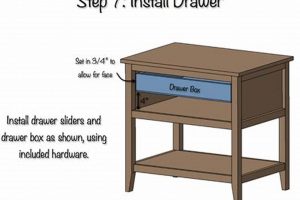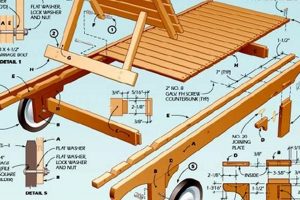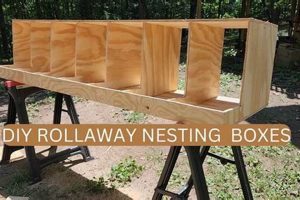A self-constructed, watercraft-towed device designed to laterally displace fishing lines away from the boat’s path. This homemade apparatus enables anglers to cover a broader area, effectively increasing the chances of locating fish. Typically crafted from buoyant materials, it floats on the water’s surface, pulling the attached fishing line outwards as the boat moves forward.
The utilization of these angler-built tools offers a cost-effective solution for expanding fishing coverage, especially beneficial for trolling applications. Their adoption allows for the presentation of multiple baits at varying distances from the vessel, thereby maximizing opportunities for attracting fish. Historically, the desire for increased fishing efficiency and resourcefulness has driven the creation and refinement of these personalized implements.
The subsequent discussion will delve into the construction process, required materials, design considerations, and optimal usage strategies for creating and deploying these valuable fishing aids. Further sections will also address the potential challenges and necessary safety precautions associated with their operation.
Construction and Deployment Tips
The following provides advice to enhance the creation and effective employment of these angling tools. Careful adherence to these recommendations contributes to optimized performance and safer operation.
Tip 1: Material Selection: Employ high-density, closed-cell foam or durable, marine-grade plastic to ensure buoyancy and longevity. Avoid materials prone to water absorption or degradation under prolonged sun exposure.
Tip 2: Hydrodynamic Design: Incorporate a keel or angled surface to promote stability and prevent erratic movement. A streamlined profile minimizes drag and ensures predictable tracking.
Tip 3: Attachment Point Reinforcement: Securely fasten the line attachment points with stainless steel hardware. Weak connection points can lead to line slippage or complete detachment under strain.
Tip 4: Line Release Mechanism: Implement an adjustable line release clip that allows for controlled detachment upon a fish strike. This prevents the apparatus from interfering with the fight.
Tip 5: Weight Distribution: Strategically position weight to maintain proper orientation and tracking. Adjust the weight to compensate for varying trolling speeds and water conditions.
Tip 6: Visibility Enhancement: Apply bright, reflective tape or paint to improve visibility, particularly in low-light conditions. This aids in monitoring and preventing collisions with other vessels.
Tip 7: Controlled Deployment Speed: Gradually introduce the equipment into the water to avoid abrupt shocks and potential damage. Maintain a consistent trolling speed to ensure stable tracking.
Following these suggestions ensures enhanced performance and reduces the risk of equipment failure or operational complications. Appropriate construction and deployment practices are crucial for realizing the full potential of these fishing aids.
The subsequent section will address potential safety considerations during operation.
1. Buoyancy
Buoyancy constitutes a fundamental operational characteristic for homemade watercraft planing devices. Its effectiveness in achieving lateral displacement of fishing lines is intrinsically linked to its capacity to remain afloat while subjected to hydrodynamic forces and line tension. Adequate buoyancy is therefore not merely desirable but essential for the planer board to function as intended.
- Material Density and Displacement
The selection of materials with low density relative to water is paramount. Closed-cell foams and certain plastics are commonly employed due to their inherent buoyancy. The volume of water displaced by the object directly correlates to the buoyant force exerted upon it, as dictated by Archimedes’ principle. Insufficient displacement results in submersion, rendering the device ineffective.
- Load-Bearing Capacity
The planing device must possess sufficient buoyancy to counteract the weight of the device itself, the resistance of the fishing line, and any additional accessories or ballast. Exceeding the load-bearing capacity compromises stability and can lead to sinking, negatively affecting the presentation of the bait. Careful calculation of weight versus displacement is crucial.
- Stability and Hydrodynamic Performance
Buoyancy distribution significantly impacts the stability and hydrodynamic performance. Uneven weight distribution or insufficient flotation can cause the device to list or capsize, disrupting its intended path and potentially tangling the fishing line. Strategic placement of buoyant materials ensures balanced operation and predictable tracking through the water.
- Durability and Longevity
The chosen buoyant material must withstand prolonged exposure to water, ultraviolet radiation, and physical stress. Degradation of the material over time reduces buoyancy and structural integrity, leading to diminished performance and potential failure. Regular inspection and maintenance are necessary to ensure sustained effectiveness.
In conclusion, buoyancy is not simply an attribute but a critical design parameter for a homemade planing device. Appropriate material selection, careful weight distribution, and consideration of long-term durability are all necessary to ensure that the device effectively and reliably performs its intended function of laterally displacing fishing lines.
2. Tracking Stability
Tracking stability is a critical performance parameter for self-constructed watercraft planing devices. The ability to maintain a consistent and predictable course through the water directly affects the precision with which fishing lines are deployed and the overall effectiveness of the fishing strategy. Without adequate tracking stability, the benefits of lateral line displacement are significantly compromised.
- Hydrodynamic Design and Hull Form
The shape and configuration of the planing device’s hull profoundly influence its tracking capabilities. A well-designed hull minimizes yaw and pitch, preventing erratic movements and deviations from the intended trajectory. Features such as keels, chines, and strategically placed angled surfaces contribute to directional stability. Examples include a deep keel that resists side-to-side movement or a V-shaped hull that cuts through the water with minimal resistance. Improper hull design results in inconsistent tracking, rendering the device less effective.
- Weight Distribution and Center of Gravity
The distribution of weight within the planing device affects its equilibrium and resistance to external forces. A low center of gravity enhances stability by reducing the tendency to roll or tip. Distributing weight evenly across the longitudinal axis prevents bow-down or stern-down attitudes, which can negatively impact tracking. Improper weight distribution leads to unpredictable behavior, especially in windy or turbulent conditions.
- Tow Point Location and Angle
The position and angle of the tow point, where the fishing line attaches, directly influence the forces acting upon the planing device. A properly positioned tow point minimizes drag and ensures that the device pulls consistently in the desired direction. Adjusting the tow point angle can fine-tune the tracking behavior, compensating for variations in boat speed or water conditions. An improperly positioned tow point creates excessive drag or causes the device to veer off course.
- Influence of External Factors
External factors, such as wind, waves, and current, significantly impact the tracking stability of a planing device. Strong winds can exert lateral forces, causing the device to drift. Waves can induce pitching and rolling motions, disrupting its course. Current can create drag and alter the device’s trajectory. Effective design and deployment strategies must account for these external factors to maintain tracking stability under varying conditions. Examples include using heavier devices or adjusting tow points to compensate for wind effects.
In summary, tracking stability is not a singular attribute but a complex interplay of design elements, weight distribution, tow point configuration, and external factors. Optimization of these elements is essential for achieving reliable and predictable performance from self-constructed watercraft planing devices, maximizing their utility in diverse fishing scenarios.
3. Line Release
The line release mechanism is an integral component of a self-constructed watercraft planing device, facilitating the controlled detachment of the fishing line upon a fish strike. Its proper function is crucial for preventing interference with the fight and ensuring effective hooksets.
- Functionality and Sensitivity Adjustment
A functional line release mechanism permits the fishing line to disengage from the device upon a fish striking the bait. Adjustable sensitivity is paramount; the release should hold firm against the drag of the lure and the planing device’s resistance but disengage cleanly upon the force exerted by a fish. For example, a spring-loaded clip allows tension adjustment, accommodating various lure weights and trolling speeds. Inadequate sensitivity results in premature releases, while excessive tension hinders proper hooksets.
- Types of Release Mechanisms
Several release mechanisms are suitable for homemade planing devices, including pinch pads, spring clips, and modified clothespins. Pinch pads employ two opposing surfaces that grip the line, while spring clips utilize tension to secure it. Modified clothespins provide a rudimentary but functional alternative. The selection depends on ease of construction, adjustability, and durability. For example, stainless steel spring clips offer corrosion resistance and consistent performance. A poorly chosen release mechanism may fail prematurely or damage the fishing line.
- Placement and Orientation
The position and orientation of the release mechanism on the planing device influences its effectiveness. The mechanism should be situated to minimize line friction and prevent tangling. Proper orientation ensures that the release is triggered by a direct pull from the fish, rather than side pressure from the planing device. An example is placing the release near the trailing edge to allow a straight pull. Incorrect placement can result in erratic releases or line breakage.
- Maintenance and Durability
Regular maintenance is essential to ensure the reliable operation of the release mechanism. Exposure to saltwater and ultraviolet radiation can degrade the materials over time, affecting performance. Periodic cleaning and lubrication prevent corrosion and maintain smooth operation. Durable materials, such as stainless steel or UV-resistant polymers, extend the lifespan of the mechanism. Neglecting maintenance leads to decreased sensitivity and eventual failure.
In conclusion, the line release mechanism is a critical aspect of a do-it-yourself planing device. A well-designed, properly maintained release enhances the angler’s ability to detect strikes, set hooks effectively, and manage fishing lines while trolling.
4. Material Durability
The longevity and operational effectiveness of a self-constructed watercraft planing device are directly correlated with the durability of the materials employed in its construction. The capacity to withstand sustained exposure to marine environments, mechanical stress, and ultraviolet radiation is paramount for realizing long-term utility.
- Resistance to Hydrolytic Degradation
Prolonged immersion in water, particularly saltwater, subjects materials to hydrolytic degradation. This process involves the chemical breakdown of polymers and other substances due to reaction with water molecules, leading to reduced strength and structural integrity. Marine-grade plastics and closed-cell foams exhibit superior resistance to hydrolysis compared to materials prone to water absorption or decomposition. The selection of hydrolysis-resistant materials ensures sustained buoyancy and structural stability of the planing device over extended periods.
- Mechanical Strength and Impact Resistance
Watercraft planing devices are subject to mechanical stress from towing forces, wave impacts, and potential collisions with submerged objects. Materials with high tensile strength, flexural modulus, and impact resistance are essential for withstanding these stresses without fracturing or deforming. Reinforced polymers, such as fiberglass or carbon fiber composites, provide enhanced mechanical properties compared to unreinforced plastics. Adequate mechanical strength ensures the structural integrity of the planing device under dynamic conditions.
- Ultraviolet Radiation Stability
Prolonged exposure to ultraviolet (UV) radiation from sunlight degrades many polymeric materials, causing discoloration, embrittlement, and loss of mechanical properties. UV-stabilized plastics and coatings incorporate additives that absorb or scatter UV radiation, protecting the underlying material from damage. Without adequate UV protection, the planing device may become brittle and prone to cracking, reducing its lifespan. Regularly applying UV-resistant coatings can prolong the material’s integrity.
- Corrosion Resistance of Hardware Components
Metallic components, such as fasteners, line connectors, and ballast weights, are susceptible to corrosion in marine environments. Galvanic corrosion, caused by the interaction of dissimilar metals in the presence of an electrolyte (saltwater), can lead to rapid degradation of these components. Stainless steel alloys with high chromium content provide excellent corrosion resistance. The use of non-metallic components, such as plastic or ceramic fasteners, eliminates the risk of galvanic corrosion. Regular inspection and replacement of corroded hardware are essential for maintaining the functionality and safety of the planing device.
The selection of durable materials is fundamental to the success of any self-constructed watercraft planing device. Careful consideration of hydrolytic stability, mechanical strength, UV resistance, and corrosion protection ensures that the device can withstand the rigors of the marine environment and provide reliable performance over an extended service life.
5. Deployment Method
The method by which a self-constructed watercraft planing device is deployed significantly influences its effectiveness and safe operation. A carefully considered deployment strategy ensures optimal line presentation, minimizes tangling, and reduces the risk of equipment damage or loss.
- Initial Placement and Orientation
The initial placement of the planing device in the water sets the stage for its subsequent operation. The device should be placed gently to avoid shock loads on the line and attachment points. Proper orientation, with the tow point facing the boat, ensures immediate and correct tracking. For example, tossing the device too forcefully can damage components or tangle the line. A controlled, deliberate placement is crucial.
- Gradual Line Release
Releasing the fishing line to the planing device should be a gradual process. Paying out line in controlled increments allows the device to move away from the boat at a predictable rate, minimizing the risk of tangling. Sudden or excessive line release can create slack, causing the device to veer erratically or become unstable. Consistent, measured line release promotes smooth and efficient deployment.
- Trolling Speed Adjustment
The trolling speed directly impacts the planing device’s performance. Excessive speed can overload the device, causing it to submerge or track poorly. Insufficient speed may result in inadequate lateral displacement of the fishing line. Careful adjustment of trolling speed to match the device’s design and water conditions is essential. For instance, heavier devices may require higher speeds to achieve optimal planing. Monitoring the device’s performance and adjusting speed accordingly ensures effective operation.
- Retrieval Technique
The method used to retrieve the planing device is as important as its deployment. A slow, steady retrieval minimizes stress on the line and device. Avoid abrupt stops or sharp turns, which can cause the device to swing violently and potentially damage the boat or other equipment. Using a long-handled net or gaff can facilitate retrieval without requiring excessive reaching. A controlled retrieval protects the equipment and ensures safe handling.
In conclusion, the deployment method is not a mere procedural step but a critical determinant of a do-it-yourself planing device’s overall performance. By paying careful attention to initial placement, line release, trolling speed, and retrieval technique, anglers can maximize the effectiveness of their fishing strategy while minimizing the risk of equipment damage or operational complications.
6. Visibility
A watercraft planing device’s conspicuity constitutes a critical safety and operational element. Adequate visibility reduces the risk of collisions with other vessels, particularly in conditions of reduced ambient light or high traffic density. Increased detectability also aids in monitoring the device’s position and trajectory, allowing for timely adjustments to maintain optimal line presentation. Lack of visibility can result in equipment loss, damage, or, more seriously, accidents with other boaters.
Enhancements for visibility can be achieved through multiple methods. High-contrast coloration, such as bright orange or yellow, increases detectability against the water’s surface. Reflective tape strategically applied to the device improves visibility at night or in low-light conditions by reflecting light from other vessels. The incorporation of a small, lightweight flag or pennant further increases visibility, especially at greater distances. For example, a dark-colored device is difficult to see against choppy water, while a brightly colored one stands out significantly. This difference in detectability contributes to safety and operational awareness.
Therefore, optimizing visibility is not merely a cosmetic consideration but a crucial aspect of the overall design and utilization of a self-constructed planing device. Prioritizing visibility through the selection of appropriate colors, reflective materials, and visual indicators enhances safety, minimizes the risk of accidents, and contributes to the effective deployment of fishing lines in diverse angling environments.
Frequently Asked Questions
The following addresses common inquiries regarding the construction, deployment, and maintenance of angler-built planing devices. These responses aim to clarify technical aspects and promote informed decision-making.
Question 1: What are the primary benefits of utilizing a DIY planer board versus purchasing a commercially manufactured unit?
Construction allows for customization to specific angling needs and preferences. Material selection, size, and line release mechanisms can be tailored to optimize performance for targeted species and fishing conditions. Cost savings are often realized compared to purchasing commercially available alternatives. However, construction necessitates proficiency in fabrication techniques and material selection to ensure durability and functionality.
Question 2: What materials are most suitable for constructing a durable and effective DIY planer board?
Closed-cell foam, marine-grade plastics, and treated wood offer suitable buoyancy and resistance to water damage. Fasteners should be stainless steel to prevent corrosion. UV-resistant coatings are recommended to extend material lifespan. Specific material selection depends on budget, skill level, and intended use.
Question 3: How does the size and shape of a DIY planer board affect its performance?
Larger devices generate greater lateral displacement, allowing for wider fishing coverage. However, increased size also increases drag and may require heavier line. A streamlined shape reduces drag and improves tracking stability. The optimal size and shape depend on boat speed, line weight, and water conditions.
Question 4: What factors should be considered when selecting a line release mechanism for a DIY planer board?
The release mechanism must provide consistent and reliable line detachment upon a fish strike. Adjustability is crucial to accommodate varying line weights and trolling speeds. Corrosion resistance is essential for durability in marine environments. The complexity of the mechanism should align with the builder’s skill level.
Question 5: How can a DIY planer board be optimized for use in different water conditions (e.g., rough seas, strong currents)?
Adding ballast weight lowers the center of gravity and improves stability in rough seas. Adjusting the tow point angle can compensate for strong currents. Increasing the size of the planing surface enhances buoyancy in turbulent waters. Adapting the design to specific environmental conditions is critical for optimal performance.
Question 6: What safety precautions should be observed when deploying and retrieving a DIY planer board?
Maintain a safe distance from other vessels and obstructions. Use high-visibility materials to enhance detectability. Avoid deploying in areas with heavy boat traffic. Exercise caution when handling lines under tension. Inspect all components regularly for wear or damage. These procedures are essential for safe operation.
This FAQ provides foundational knowledge for individuals contemplating the construction and use of a planer board. Implementing these suggestions and suggestions will promote a beneficial fishing experience.
The subsequent segment will cover potential troubleshooting strategies for addressing common operational challenges encountered with homemade planing devices.
Conclusion
This exposition has detailed the intricacies of the diy planer board, addressing construction, deployment, and operational considerations. Key aspects, including material selection, hydrodynamic design, line release mechanisms, and visibility enhancements, have been thoroughly explored. Adherence to these principles directly impacts the effectiveness and safety of these angler-built tools.
The successful utilization of the diy planer board depends on a comprehensive understanding of the aforementioned concepts. Further research, experimentation, and adherence to responsible angling practices are encouraged. Continued refinement of construction techniques and deployment strategies will enhance the fishing experience and promote sustainable resource management.







